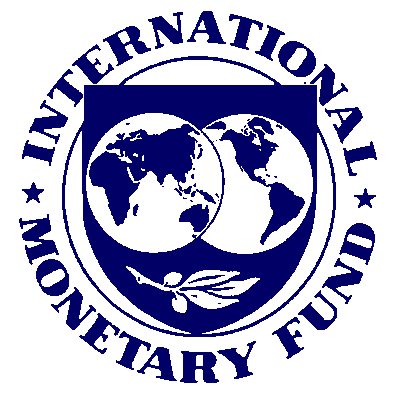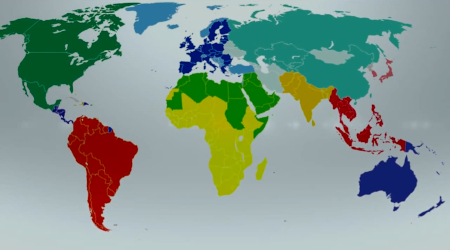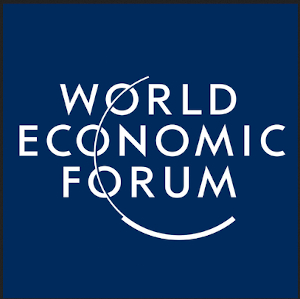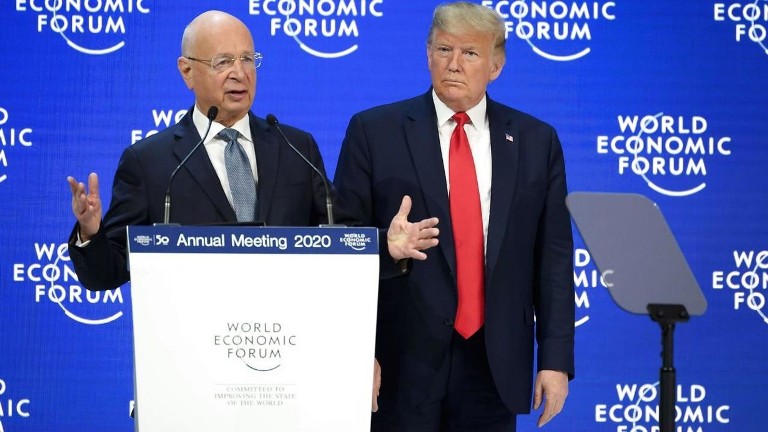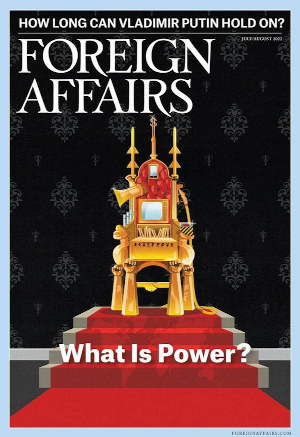
IMF chief: Countries must ‘make the best’ of new multipolar world
ACCELERATE REGIONALIZATION
AFP | France 24, April 17, 2025 – Countries have no choice but to “make the best” of the fragmentation of the global economy by boosting ties with regional and like-minded countries, the head of the International Monetary Fund said in an interview Thursday.
“Yes, (it’s) much better for the world to get one system of rules, much better, and hopefully we will retain the basic principles of this common system for the future,” IMF Managing Director Kristalina Georgieva told AFP.
“But we are in a multipolar world,” she said…. “And in this environment, it is likely to continue, maybe even accelerate, so we will see more bilateral and plurilateral agreements,” she said, pointing to places like southeast and central Asia, and Gulf Cooperation Council (GCC) countries.
Region News Index
● AFRICAN UNION, Subregions: ECOWAS, EAC, ECCAS, COMESA, SADC
● ARAB LEAGUE
● ASEAN (Association of Southeast Asian Nations)
● EAU (Eurasian Union)
● EU (European Union)
● GCC (Gulf Cooperation Council)
● USMCA, NAFTA (United States, Mexico, Canada)
● PIF (Pacific Islands Forum)
● BIMSTEC, SAARC (South Asia)
● MERCOSUR, UNASUR, CELAC (South America)
THE NEW REGIONAL ORDER:
The rise of Regionalism in World Politics: Trends and Implications
COUNTRIES TURNING TO REGIONAL BLOCS TO SECURE POLITICAL, SOCIO-ECONOMIC, STRATEGIC INTERESTS
TRUMP’S NATIONALISM AMPLIFYING SHIFT FROM GLOBALISM TO REGIONALISM
Modern Diplomacy, May 7, 2025 – As global institutions are clinging to life and multilateralism appears to be not as effective as it was, the regional blocs are experiencing a significant rise in their strength and influence, on the contrary. The return of US President Donald and his nationalist policies and priority for domestic interests over global cooperation has amplified this shift further and ushered in a renewed emphasis on regionalism. The world is now witnessing a growing trend where countries are turning to regional partnerships to secure their political, socio-economic, and strategic interests. Various regions from Europe to Asia, Latin America to Africa, and the Middle East are responding by bolstering intra-regional cooperation….Although this development presents fresh chances for group resilience, it also necessitates cautious handling to keep regionalism from turning into a cause of conflict and instability.
‘FRAGMENTED’ BRICS ALTERNATIVE TO DOLLAR:
Impact of Central Bank Digital Currencies on Regional Power Dynamics
PROMOTING FRAGMENTATION INTO REGIONAL BLOCS
BRICS NATIONS TO GAIN LEVERAGE BY OFFERING THEIR CBDC CURRENCIES AS ALTERNATIVES, DEEPENING INTRA-REGIONAL TRADE
The International Banker (UK), Aug 27, 2025 – The International Banker, Aug 27, 2025 – The proliferation of CBDCs is fostering alternative cross-border networks, such as mBridge, and connecting central banks in China, the United Arab Emirates (UAE), Saudi Arabia and others to share liquidity and settle in local digital currencies. This model presents a stark contrast to the single interconnected US dollar system, instead promoting fragmentation into regional blocs defined by their own digital rails. Such a fragmented architecture challenges the dollar’s primacy, shifting economic gravity toward emerging power centers, especially China and other BRICS nations, which gain leverage by offering their currencies and infrastructures as alternatives….
As a result, countries within regional blocs (for example, the Belt and Road Initiative [BRI] and the Regional Comprehensive Economic Partnership [RCEP]) can bolster economic autonomy while deepening intra-regional trade and influence, ushering in a multipolar financial ecosystem.
EMPOWERING A NEW REGIONAL ORDER:
U.S. may impose regional tariffs as trade deadlines loom, Bessent says
BESSENT: ‘WE WILL DO A LOT OF REGIONAL DEALS’
Axios, May 18, 2025 – The U.S. may impose some tariffs by region rather than on individual countries, as time runs out to negotiate a laundry list of trade deals globally, Treasury Secretary Scott Bessent said Sunday.
The administration is quickly curtailing its 90-deals-in-90-days ambition, acknowledging the practical realities of trying to negotiate complex trade agreements with dozens of countries simultaneously….
“My other sense is that we will do a lot of regional deals — this is the rate for Central America, this is the rate for this part of Africa — but what we are focused on for right now is the 18 important trading relationships,” Bessent said.
‘You’re going to see regional orders spring up’
‘Because it’s so hard to create a world order’

“I think you’re going to see the evolution of regional organizations, and that regional – because it’s so hard to create a world order – I think you’re going to see regional orders spring up. And then you would have links between regional orders. But they will be very much guided by economic interests, social interests and also security interests….”
Frederick Kempe, President and CEO, Atlantic Council
Comments at the World Government Summit, March 29, 2022
(Video excerpt starts at 17:11)
SIX FORMER CIA DIRECTORS ON THE ATLANTIC COUNCIL BOARD OF DIRECTORS
Regional ‘orders’ promoted as incremental step toward world order
MORE QUOTES FROM GLOBALISTS TO DEVELOP REGIONAL BLOCS
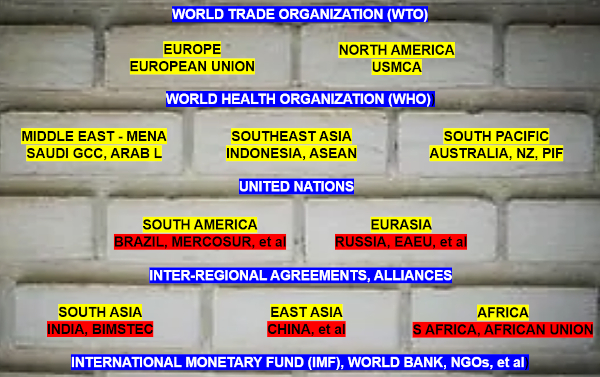
Henry Kissinger, Zbigniew Brzezinski, Klaus Schwab, others …
even Vladimir Putin: “These are the integration bricks”
Trump’s Tariff Gambit
DRIVING COUNTRIES TOWARD REGIONAL BLOCS
Counterpunch, April 17, 2025 – His focus will not be on structural reform or meaningful trade rebalancing but on political messaging, painting himself as the only one willing to confront the “China threat.” This approach, however, will only further destabilize the rules-based trading system that the United States helped build, driving more countries toward hedging strategies and regional blocs.
THE ‘NEW MERCANTILISM’:
Trump and fear : the new alliance between mercantilism and geopolitics
PROJECTION OF A WORLD DIVIDED INTO CONTINENTAL BLOCS
Etudes Economiques, Jan 16, 2025 – The final stage of the Trump rocket is the continental projection of power and the capture of resources…. This sort of “mercantilist geopolitics” was on display at the muddled press conference he gave at Mar-a-Lago last week. …This type of projection of a world divided into continental blocs controlled by dominant powers – a well-known pre-war grammar – risks encouraging those nostalgic for empire, and those who would like to belong to the club of powerful countries, to move from thought to action.
FROM THE ARCHIVES: KISSINGER’S ‘NEW MERCANTILISM’ OF ‘COMPETING REGIONAL UNITS’:
HENRY KISSINGER, ‘THE CHANCE FOR A NEW WORLD ORDER’
New York Times, Jan 12, 2009 – Full text
‘MULTIPOLAR’ REGIONAL ORDER:
Global Non-West And Multipolarity
LINKED BRICS, REGIONAL BLOCS CAN BECOME CATALYST FOR MULTIPOLARITY AGAINST ‘WESTERN HEGEMONY’
Geopolitica.ru, (Russia), May 5, 2025 – Anti-colonialism, strengthening sovereignty, technological development and honest international cooperation are the main criteria of the BRICS club…. There are also separate regional structures, such as ASEAN and SAARC in Southeast and South Asia, the African Union(AU) in Africa, the League of Arab States (The Arab League) in the Middle East, CELAC, UNASUR and ALBA in Latin America, and the Eurasian Economic Union in the former Soviet Union. There is also the supra-regional Organization of Islamic Cooperation…. The creation of new links between all these structures can become an additional catalyst in the formation of multipolarity and reducing the influence of Western hegemony….
Economic Outlook for 2025 Weighed Down by Fragmentation, Debt and Political Uncertainty
World Economic Forum, Jan 16, 2025 – Business responses to the increasing fragmentation of the global economy are expected to include restructuring supply chains (91%), regionalizing operations (90%) and focusing on core markets (79%).
The Future of Globalization: Regionalization and the Emerging Economic Order
REGIONAL TRADE AGREEMENTS EMERGE AS POWERFUL INSTRUMENTS, ENABLING NATIONS TO SYNCRONIZE ECONOMIC POLICIES
Global Banking & Finance Review (London, UK), Jan 15, 2025 – Regional alliances and trade agreements are surfacing as mechanisms for mitigating geopolitical risks and enhancing economic resilience. These alliances often operate based on mutual interests and complementary economic profiles, creating more robust and adaptable markets to global disruptions.
For instance, the Regional Comprehensive Economic Partnership (RCEP) in Asia—uniting ASEAN nations with major economies like China, Japan, and South Korea—illustrates the strategic pivot towards creating self-sufficient regional economic hubs….
Regional trade agreements emerge as powerful instruments, enabling nations to synchronize economic policies while fostering market access, and ensuring stability in a fragmented geopolitical environment.
A New Age of Empire? Trump, Trade Wars and Global Fragmentation
TRUMP’S TARIFFS RESHAPING WORLD INTO FRAGMENTED BLOCS
The Wire, April 14, 2025 – Trump’s second term represents both the symptom and the cause of a structural crisis in global capitalism. His aggressive tariffs, retreat from multilateralism and oligarchic consolidation are reshaping the world economy into fragmented blocs, undermining the liberal global order.
Beyond tariffs: The new era of managed trade
REGIONAL TRADE BLOCS ARE STRENGTHENING
Philstar Global (Philippines), April 8, 2025 – Instead of broad multilateral trade frameworks involving many countries, there seems to be a shift toward country-specific trade terms. This, in turn, appears to be encouraging regionalization over globalization – regional trade blocs are strengthening as global integration faces headwinds.
Global Non-West And Multipolarity
LINKED BRICS, REGIONAL BLOCS CAN BECOME CATALYST FOR MULTIPOLARITY AGAINST ‘WESTERN HEGEMONY’
Geopolitica.ru, (Russia), May 5, 2025 – Anti-colonialism, strengthening sovereignty, technological development and honest international cooperation are the main criteria of the BRICS club…. There are also separate regional structures, such as ASEAN and SAARC in Southeast and South Asia, the African Union(AU) in Africa, the League of Arab States (The Arab League) in the Middle East, CELAC, UNASUR and ALBA in Latin America, and the Eurasian Economic Union in the former Soviet Union. There is also the supra-regional Organization of Islamic Cooperation…. The creation of new links between all these structures can become an additional catalyst in the formation of multipolarity and reducing the influence of Western hegemony….
BRICS to build ‘New World Order’: Russia calls for alternative to IMF and World Bank
“WE HAVE ALSO INVITED THE CURRENT CHAIRS OF INFUENTIAL REGIONAL INTEGRATION ORGANIZATIONS IN AFRICA, LATIN AMERICA, THE MIDDLE EAST, AND SOUTHEAST ASIA”
Kitco News, Oct 11, 2024 – ….Russian President Vladimir Putin has also joined the call to build a new international framework with BRICS allies….
“Russia is in favor of the widest possible international discussion on the parameters of interaction in the emerging multipolar world and is open to discussing the issues of building a new world order with all our friends, partners, and like-minded people, including within the CIS, the EAEU, the Shanghai Cooperation Organization, and BRICS,” Putin said. “It is in this spirit that we are preparing the BRICS and Outreach/BRICS Plus summit to be held in Kazan on October 22-24.”….
[Iranian President Masoud] Pezeshkian also highlighted the importance of cooperation between the two states in BRICS, the Shanghai Cooperation Organization (SCO) and the Eurasian Economic Union (EAEU)….
“A whole number of ASEAN countries have been invited to attend the [BRICS] summit and these invitations have been accepted,” [Russian Foreign Minister Sergey Lavrov] said. “I have no doubts that the approaches being developed within BRICS to various issues of the agenda can quite be of interest for participants in East Asia summits, especially for member states of the Association of Southeast Asian Nations.”
And Russia’s plans for BRICS expansion extend beyond the ASEAN region….
“We have also invited the current chairs of influential regional integration organizations in Africa, Latin America, the Middle East, and Southeast Asia. In addition to state leaders and senior officials, the summit will, as usual, be attended by the secretaries-general of the UN, the Shanghai Cooperation Organization, the Commonwealth of Independent States, the Eurasian Economic Union, the Union State, and the president of the New BRICS Development Bank.”ANTALYA DIPLOMACY FORUM 2025:
Takeaways from Antalya: Diplomacy is the way out of a fragmented world
LAVROV: “THERE IS NO WORLD ECONOMIC GLOBALISATION ANYMORE”
“DEEPER STRATEGIC COOPERATION” WITH CHINA, INDIA, REGIONAL BLOCS
TRT Global (Türkiye), April 17, 2025 – ….No less forceful was the intervention of Russia’s foreign minister, Sergey Lavrov….Lavrov said that “there is no world economic globalisation anymore,” blaming not Donald Trump but Joe Biden for “destroying” the global financial system through sanctions….
Lavrov’s sharper comments were reserved for the Global South. “The new world order will only be possible if these geographies recover,” he said, referencing Africa, Asia, Latin America, and the Middle East.
His remarks were a reference to deeper strategic cooperation with emerging powers such as China and India, as well as with blocs like the Shanghai Cooperation Organisation, ASEAN, and the Eurasian Economic Union, among others.
The Future Of Global Peace: Why The UNSC Needs Comprehensive Reform – Analysis
CALL FOR REGIONAL REPRESENTATION WITHIN UN SECURITY COUNCIL GAINING MOMENTUM
Eurasia Review, Sept 15, 2024 – ….Another concept that is gaining momentum is the call for regional representation within the UNSC. This would entail allocating permanent seats to regional groups such as the African Union, the Arab League, or the Pacific Islands Forum. Such an approach could resolve some of the dilemmas regarding which specific countries should be chosen to represent larger regions. However, this model also raises concerns about how to ensure effective leadership and decision-making within these regions, as well as how to strike a balance between regional representation and the necessity for global consensus.
FROM THE ARCHIVES: ‘A GLOBAL FORM OF FEDERALISM’ – (Full Transcript)
“WE COULD ORDER THE WORLD ON THE BASIS OF EXISTING REGIONAL COOPERATION ORGANIZATIONS”
Klaus Schwab’s ‘Great Reset’ includes region building
World Economic Forum’s transhumanist founder promotes ‘regionalization’ as globalism’s post-COVID compromise with nationalism
REGIONAL BLOCS, REGIONAL SUPPLY CHAINS WOULD BE AN ‘IN-BETWEEN SOLUTION…A NEW WATERED-DOWN VERSION’ OF GLOBALIZATION
by Tim Porter
Klaus Schwab had made it clear in a 2016 televised interview. Asked when the world would see chips implanted in humans, Schwab replied, “Certainly in the next ten years. At first we will implant them in our clothes, and then we could imagine that we will implant them in our brains or in our skin. And in the end, maybe, there will be a direct communication between our brain and the digital world. What we see is a kind of fusion of the physical, digital and biological world.”
Public reaction to these audacious “in your face” ideas, by comparison, may appear to have buried some of Schwab’s other topics like “regionalization” into the obscure pages of his Great Reset. But regionalization should merit the audacious label in its own right, as its establishment would mark an unprecedented era in modern history, rendering national sovereignty obsolete.
KING NEB’S ‘FEET AND TOES’? Daniel 2: 40-45
Globalization isn’t as dead as you think | Opinion
‘Regional hubs will create a world led by two nearly equal powers, surrounded by trade satellites’
Penn Live, May 12, 2023 (Pittsburgh Post-Gazette, June 7) – The notion of the ‘one large power’ is over. The idea is that globalization could never have been a monolith – a self-sustaining whole but rather something that is interrelated with local and regional needs. Regional hubs will create a world led by two nearly equal powers, surrounded by trade satellites – one we expect to be a U.S.-led side that includes USMCA, Latin America, and Europe. The other, a Chinese-led side that will include Asia-Pacific, Central Asia, and parts of Africa.
The writer’s number of regional “satellites” is short of the roughly ten major regional blocs in that are in existence today. They are still in a state of flux, conflict, development and consolidation of power, but the Bible’s latter-day scenario of ten contemporaneous kingdoms is coming into view.
IMF Report: ‘Reduced cross-border trade flows…could result from the world fragmenting into multiple blocs’
Risks of further global trade fragmentation ‘becoming more salient’
International Monetary Fund Regional Economic Outlook, Asia and Pacific, May 2023 (Page 10) – “Risks of further global trade fragmentation are becoming more salient, considering ongoing US-China trade disputes (including new restrictions on trade in high-tech products) and heightened geopolitical tensions linked to Russia’s war in Ukraine. Asia remains especially vulnerable to reduced cross-border trade flows…and foreign direct investment…that could result from the world fragmenting into multiple blocs, with Asia’s exporters heavily exposed to the China, Europe, and the United States…”
Download Full IMF Report here.
‘REGIONALIZATION’ AND THE NEW REGIONAL ORDER:
The Myth of the Global:
Why Regional Ties Win the Day
‘REGIONALIZATION, NOT GLOBALIZATION, WILL SET THE CORPORATE AGENDA’
By Shannon K. O’Neil, Foreign Affairs, July-Aug 2022
(Foreign Affairs is published by the Council on Foreign Relations)
….During the COVID-19 pandemic, border closures and rising transportation costs have prompted companies to consider bringing production closer to home…. The most probable scenario is that multinationals will turn away from globalized supply chains in favor of shorter, more duplicative regional ones. Regionalization, not globalization, will set the corporate agenda in the coming decades….
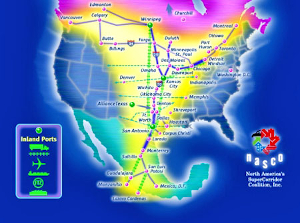
To enhance North America’s regionalization, the continent needs to improve its linking infrastructure…. As parts and components move between the three countries, workers must be able to follow.
Shannon K. O’Neil is the Nelson and David Rockefeller Senior Fellow for Latin America at the Council on Foreign Relations. She is the author of the book The Globalization Myth: Why Regions Matter, from which this essay is adapted.
From its very outset within the title, this essay by Shannon K. O’Neil embarks on a mission of false choices and unsupported assertions. For instance:
If, as O’Neil maintains, natural disasters from “climate change” can jeopardize overextended, global supply chains more than shorter, faster regional supply chains, then shorter, faster national supply chains would be an even more favorable option. But this “reshoring” option is not offered, except only to be dismissed with this strange, hasty generalization: “as costs rise and innovation falls.”
O’Neil recognizes that advances in production require a labor pool with greater skills and less workers. For what benefit, then, does she advocate that “tens of millions of people could be energized” when a massive EU-style labor pool could move freely across North America’s national borders?
O’Neil presents a “regionally focused world” as the reality, citing the European Union’s common labor pool, passport and currency as its model. But O’Neil sidesteps the fact that this “reality” has been created. This “reality” is based upon a series of multilateral/bilateral agreements favoring a utopian globalist mindset that gave us open-border chaos and the global supply chain debacle.
Calling globalism a “myth” is O’Neil’s attempt to distance globalists from the very real global mess that they created, while also attempting to walk back the same erroneous, delusional mindset into a more “sustainable” regional context.
As a mouthpiece for the globalist Council on Foreign Relations, O’Neil also parrots Klaus Schwab, founder of the World Economic Forum. Schwab promotes “regionalization” as globalism’s post-Covid compromise with nationalism. Regional blocs and regional supply chains are his “in-between solution….a new watered-down version” of globalization.
FOUR SHADES OF DEGLOBALIZAION
CONTRIBUTING FACTORS ‘REVERSING THE COURSE OF GLOBALIZATION’
Phys.org, May 13, 2022 – One can read the current moment as a shift from true globalization to a situation in which trade is reorganized into regional clusters, with the United States, Europe, China and others at the center of smaller, more cohesive networks.
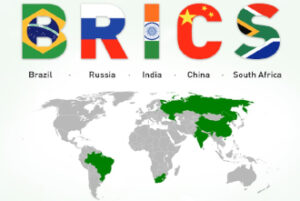 Can BRICS Underpin a New World Order?
Can BRICS Underpin a New World Order?
REGIONAL BLOC NETWORK BY ‘INTEGRATION OF INTEGRATIONS’
Modern Diplomacy, April 18, 2022 – A platform for interactions between regional integration blocs involving BRICS states could become another track of interaction within BRICS+. Such a platform could include priority projects of regional integration involving BRICS states, such as MERCOSUR, SACU, BIMSTEC, the EAEU, as well as the RCEP or the ASEAN-China Free Trade Area. All these regional blocs could cooperate in coordination, moving toward aligning their standards and creating a more open economic space for trade and investment by BRICS states and their regional partners. It is important to notice that most BRICS states currently choose to shape their foreign policies in the form of regional integration blocs (Russia – the EAEU, Brazil – MERCOSUR, South Africa – the SACU), and, consequently, BRICS+ based on “integration of integrations” is the only possible format for economic integration and for opening markets between BRICS states.
‘REGIONALIZATION’

THE WEAPONIZATION OF INTERDEPENDENCE – AND OTHER CONSEQUENCES OF THE WAR IN UKRAINE
‘REGIONALIZATION OF GLOBALIZATION’
The Hill, April 4, 2022 – We’re seeing how fragile the international system is, as it fragments into regional blocs, as digital currencies are accelerating efforts to reduce the global role of the dollar. But all told, it appears more a scaling back and regionalization of globalization than its demise.
THE RESTRUCTURING OF INTERNATIONAL CAPITAL MARKETS UNDER DEGLOBALIZAION
‘PARADIGM SHIFT’ FROM GLOBALIZATION TO REGIONALIZATION
Modern Diplomacy, April 1, 2022 – Tony Pasqsuariello, global head of hedge fund coverage at Goldman Sachs, has said that the world is now undergoing a “paradigm shift” from globalization to regionalization.
‘SLOW-BALIZATION’: HOW WAR AND THE PANDEMIC ARE RESHAPING GLOBAL TRADE
WORLD ECONOMY MOVING TOWARDS REGIONALIZATION
Japan Times, April 1, 2022 – The Ukraine-Russia conflict has highlighted the risks of globalization and accelerated a trend of deglobalization.
‘REGIONAL SELF-SUFFICIENCY’ TO REPLACE GLOBAL SUPPLY CHAINS
Post-pandemic: welcome to the multi-speed world of regional disparities
Global Geneva, April 26, 2020 – The coronavirus swept across the world from Asia to Europe to the US along the same supply chains that deliver our electronics and clothing. But even as it serves as a reminder that we live in an interconnected world, it does not signify that we are all going to be in the same boat moving forward. On the contrary, the multi-speed global economy will continue to diverge as North America, Europe, and Asia focus more on regional self-sufficiency than far-flung global supply chains….
Regionalism was already overtaking globalism before COVID-19. Owing to the US-China trade war, by 2019 America’s trade with each Canada and Mexico had risen to above US$300 billion per year, while US-China trade had fallen to $270 billion. Meanwhile, China’s trade with its Southeast Asian neighbors in ASEAN had nipped $300 billion, showing how Asia continues to integrate…. For its part, Europe had also announced in 2019 an EU-wide strategic industries initiative to support more national champions in clean-tech and other industrial areas to stave off competition from China.
THE NEW WORLD ORDER OF REGIONS:
Why the World Is Not Falling Apart as Much as You May Think
‘Not fragmentation of countries but integration within regions’
The World Post (Huffington Post, Berggruen Institute), April 22, 2016 – By most accounts, the world is splintering. Geopolitical blocs are forming once again, the nuclear arms race is reigniting and religious war rages. Globalization is in retreat as publics across the planet suspect trade agreements, politicians talk about building walls and refugees are turned away. Yet, as Parag Khanna, author of the new book, “Connectography,” writes this week from Singapore, “the same world that appears to be falling apart is actually coming together.”
“It turns out,” says Khanna, “that what most defines the emerging world is not fragmentation of countries but integration within regions.” He illustrates with maps how “major world regions are forging dense infrastructural connectivity and reorienting their relations around supply chains rather than borders” and speculates that, “a peaceful world may emerge as a collection of such stable regions and continents.”
History has demonstrated that such larger geopolitical jurisdictions will not bring a “peaceful world,” but an oppression of populations by the fascist-minded feudal lords of this “new mercantilism.”
European Union model
‘This is a lesson for all other regions of the world’
Daily Times (Pakistan), Jan 18, 2016 – ….However, the region has integrated itself into one of the most economically integrated regions of the world, known as the European Union. Some of the salient features of this Union are free trade, a common currency and a single visa policy for all the member countries…. This is a lesson for all other regions of the world, which are struggling towards integrating themselves due to political reasons.
A region which can learn from the European Union is South Asia…. All countries in this region blame the political tensions between Pakistan and India to be a major hurdle towards economic integration in South Asia…. But the question arises, how did Europe managed to set aside all its differences and integrate? If Europe can do it, why can’t we? 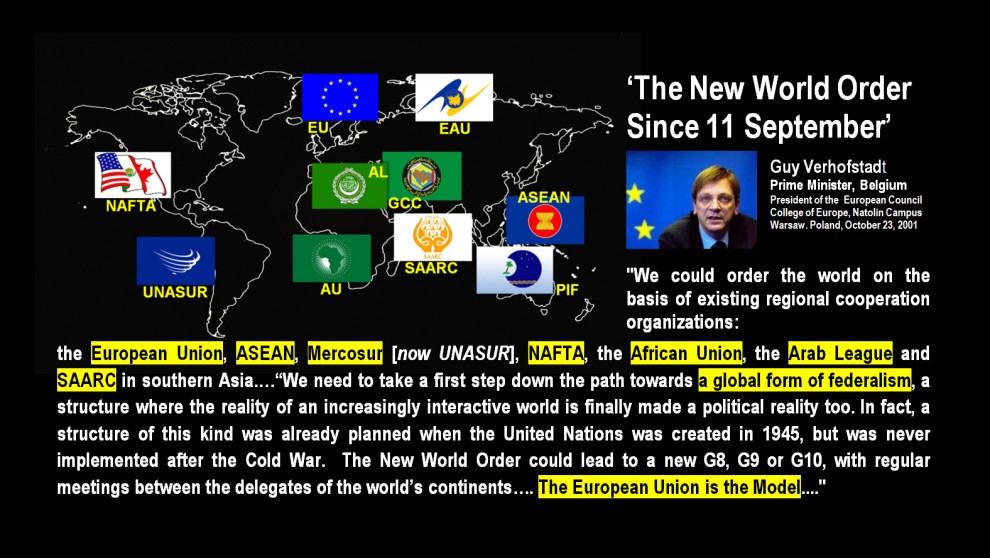
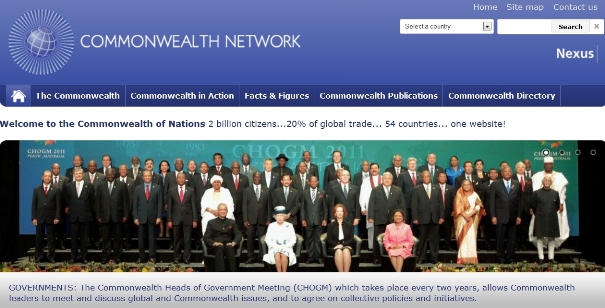
What are the ties that bind us?
British Empire/Commonwealth members form basis for global network of regional blocs
IOL News (South Africa), Sept 9, 2015 – The British Empire began evolving into the Commonwealth between the two world wars…. Economically, Commonwealth countries are divided between those who are members of the European Union (EU), the Caribbean Community (Caricom), Economic Community of West African States ECOWAS, Southern African Development Community and the East African Community, and the South Asian Association for Regional Cooperation…. Pan-Africanism and the African Union also form strong bonds between states who are also Commonwealth members.

BLOC HEADS Part 9 of 10: ORIGIN of REGIONALISM-RHODES-RUSKIN 13:23
Crisis and Strategic Integration: Towards a world of blocks
By Kintto Lucas, Radio La Primerisima (Nicaragua), August 5, 2013 (Google Translate) – Given the crisis of traditional multilateralism emerges a new multilateralism that is strengthened in new expressions such as the BRICs (Brazil, Russia, India and China), and integrative processes as occurring in Latin America, Eurasia, Asia and Africa. Strategic processes into a world of blocks, multipolar. UNASUR (Union of South American Nations) is one of the best examples of strategic integration process of new type.
Writer, journalist. Former Vice Chancellor of Ecuador. Uruguay currently Ambassador-to UNASUR, CELAC and ALBA.
SAARC in the NEW WORLD ORDER:
Is the old world order breaking down? Perhaps
The Daily Star (Bangladesh), Sept 28, 2014 – So it is assumed that a new world order may slowly replace the old. Unless there is a coherent strategy to establish a world order within regions, there is likely to be chaos and world disorder….. It is, therefore, important that our regional organisation Saarc discusses the matter of world order in future.
Putin: Key Player in the “New World Order”
By Alex Newman, The New American, Sept 23, 2014 – ….But what if everything is not quite as it seems? What if — despite the “East vs. West” and “New Cold War” hysteria whipped up by politicians and the mainstream media — both sides are actually working toward the same goals using largely the same means? Sounds impossible, right? The evidence, however, suggests it is not only possible — it is exactly what is happening….
Putin’s saber rattling over Ukraine is providing a rationale for continued Western integration — via the EU, NATO, and the “transatlantic partnership” — to counter the Russian bear. But in addition, Putin is also pursuing a “New World Order” via the regionalization approach. Chief among the schemes, for now at least, is the “Eurasian Union,”….
Preferential bilateral agreements should not replace global trade system — Russian PM
World trade rules must be universal and should be developed within the framework of the WTO, Dmitry Medvedev says
Tass (Russia), Nov 18, 2015 – Russian Prime Minister Dmitry Medvedev has voiced confidence that preferential bilateral agreements must not replace the global trade system.
“Russia has consistently advocated the deepening regional integration. All preferential trade agreements reached within its framework are important, of course, but, nevertheless, they should not replace the multilateral trade system. Moreover, they should not destroy the existing economic ties, they should only enrich them,” Medvedev said speaking at the APEC CEO summit. He recalled, in particular, that the Eurasian Economic Union (EAEU) had existed for almost a year now, adding that it comprised five full-fledged members. “We are committed to establishing mutually advantageous cooperation with all partners across the globe. This is our contribution to such integration,” Medvedev said.
Article by Prime Minister Vladimir Putin
‘A new integration project for Eurasia’
By Vladimir Putin – Mission of Russian Federation to European Union, October 10, 2011 – ….It took 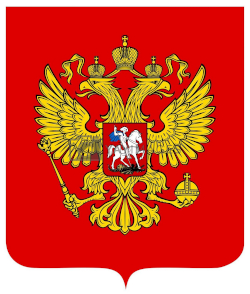 Europe 40 years to move from the European Coal and Steel Community to the full European Union. The establishment of the Customs Union and the Common Economic Space is proceeding at a much faster pace because we could draw on the experience of the EU and other regional associations…. We plan to go beyond that, and set ourselves an ambitious goal of reaching a higher level of integration – a Eurasian Union…. We believe that a solution might be found in devising common approaches from the bottom up, first within the existing regional institutions, such as the EU, NAFTA, APEC, ASEAN inter alia, before reaching an agreement in a dialogue between them. These are the integration bricks that can be used to build a more sustainable global economy.
Europe 40 years to move from the European Coal and Steel Community to the full European Union. The establishment of the Customs Union and the Common Economic Space is proceeding at a much faster pace because we could draw on the experience of the EU and other regional associations…. We plan to go beyond that, and set ourselves an ambitious goal of reaching a higher level of integration – a Eurasian Union…. We believe that a solution might be found in devising common approaches from the bottom up, first within the existing regional institutions, such as the EU, NAFTA, APEC, ASEAN inter alia, before reaching an agreement in a dialogue between them. These are the integration bricks that can be used to build a more sustainable global economy.
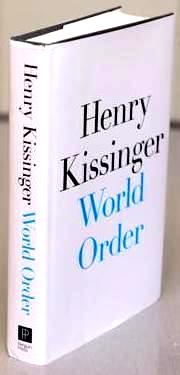
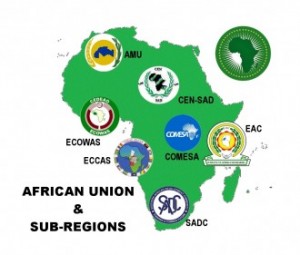
In African Union, Globalist Agenda Becomes Clear
Kissinger: world order will require ‘concept of order [regional government] within the various regions and to relate these regional orders to one another’
By Alex Newman, The New American, Sept 21, 2015 – In Africa, owing to a lack of infrastructure and communications, unifying the entire continent all at once is simply not practical. So, globalist planners — both from the “West” and from the “East” — are making use of sub-regional governments that will eventually all be merged under the emerging single African regime….
That, in essence, is what globalist forces eventually hope to do to the entire world. Once national governments worldwide finish surrendering their sovereignty to regional regimes — the EU, the AU, Vladimir Putin’s Eurasian Union, the Union of South American States (UNASUR or UNASUL), the North American Free Trade Agreement (NAFTA), the Association of Southeast Asian Nations (ASEAN), the Middle-East Union, and more — all of the regional blocs will be subsumed under a single global authority.
None of this is a secret, and those involved in the agenda have openly boasted of their machinations. “The contemporary quest for world order [world government] will require a coherent strategy to establish a concept of order [regional government] within the various regions and to relate these regional orders [governments] to one another,” explained senior globalist Henry Kissinger in his latest book, World Order.
BRICS Development Bank an Instrument for Globalization
Foreign Policy Journal, July 14, 2015 – The concept of BRIC was floated within Goldman Sachs in 2001 by Jim O’Neil, in his Global Economics Paper, “Building Better Global Economic BRICs”.[3] He called it the “BRICs dream,” in a 2003 paper, “Dreaming with BRICs: The Path to 2050.” So far from the BRICS development bank being in so-called “rivalry” with the International Monetary Fund, the BRICS call for the reform of the IMF and the world economic system originates within the international financial system…. During the 1970s the same push for reform of the IMF and the world financial system, with the “third world” as the focus, was being sold as a supposed initiative from the “developing economies.” It was called the “new international economic order,” and behind the façade of helping the “third world,” the actual purpose was to have the developed economies assume the burden of debt accrued by the “third world” to the international financiers….
The developing economies, which have historically been suspicious of “Western” capital, are—it seems—going to be opened up through the back door. It will be the BRICS bank rather than the IMF imposing the same types of economies…. BRICS could serve as the means of penetrating the “developing economies” of states that have suspicion and resentment towards the IMF…. In this case, it is being done behind the façade of assisting the “developing economies” to achieve parity. Who better to lead this than China, the totalitarian capitalist state par excellence, still posing as the champion of the “third world” against the “West.”
Every BRICS member, (Brazil, Russia, India, China, South Africa) except China, is a dominant anchor nation in a regional bloc, within the structure of the Western financial system. Recent reports indicate China’s possible entry into either SAARC (South Asia) or Putin’s Eurasian Union.
Forget ‘Nation-Building’ – Now it’s ‘Region-Building’
By Tim Porter, Dec. 26, 2011 – What exactly are the U.S. objectives in all of these military deployments? President Obama’s latest deployment announcements shed broader light upon this habitual misuse of our military.
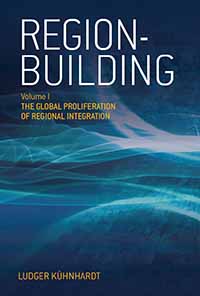
REGION-BUILDING: The Global Proliferation of Regional Integration
This two-volume text was published in July, 2010. It’s author, Bonn University political science professor Ludger Kühnhardt, is a European Union advocate and insider, having been a consultant for the secretary general of the Council of Europe and for the president of the European Parliament.
The text describes the globalists’ motives for regionalization, gives an overview of all the world’s major regions and sub-regions, and describes the agreements and treaties that have incrementally phased these regions into existence. The book summary begins with the following:
After two centuries of nation-building, the world has entered an era of region-building in search of political stability, cultural cohesion, and socio-economic development. Nations involved in the regional structures and integration schemes that are emerging in most regions of the world are deepening their ambitions, with Europe’s integration experience often used as an experimental template or theoretical model.

Globalist Henry Kissinger Outlines “New World Order” – By Alex Newman, The New American, Sept 1, 2014 ….Kissinger hints at what may be in store for humanity if it continues to resist the imposition of a “structure of international rules and norms” — a phrase that sounds suspiciously like world government. “The penalty for failing will be not so much a major war between states (though in some regions this remains possible) as an evolution into spheres of influence identified with particular domestic structures and forms of governance,” he said. “At its edges, each sphere would be tempted to test its strength against other entities deemed illegitimate. A struggle between regions could be even more debilitating than the struggle between nations has been.”
Using opaque language, Kissinger also essentially spelled out the globalist road map going forward: Rather than creating a global government all at once, dividing up the world’s peoples and nations into various “regions” ruled by regional regimes must come first.
Henry Kissinger on the Assembly of a New World Order – By Henry Kissinger, Wall Street Journal, Aug 29, 2014
The contemporary quest for world order will require a coherent strategy to establish a concept of order within the various regions and to relate these regional orders to one another….
The European Union’s current crisis with Putin’s Eurasian Union over Ukraine is a prime example of Kissinger’s emerging regional “spheres” testing strength against one another in a “struggle between regions.” Such crises only serve to consolidate power further at the regional level, away from the sovereignty of each region’s member nations. In his 2009 New York Times op-ed, “The Chance for a New World Order,” Kissinger described this coming stage toward world order as a “new mercantilism” of “competing regional units.”
Regional multilateralism: The next paradigm in global affairs – CNN, Jan. 14, 2012 – For instance, in the Far East the U.S. and the EU both cooperate with ASEAN. China and Russia have extended their ties through the Shanghai Cooperation Organization. This however did not prevent Russia from establishing the Eurasian Union, in a way reclaiming its sphere of influence. The Middle East, on the other hand, is in dire need of broader – albeit imaginative – regional integration.
The utopian evil of free trade – WND, October 14, 2012 – Free-trade advocates often point to the free movement of goods, capital and labor in the domestic economy and ask why the same system cannot work internationally since it works so well within the national borders. The reason is simple: The nation cannot continue to exist if the same degree of labor movement takes place across the borders as it presently does within them.
Socialist International Congress Demands Global Gov, Wealth Redistribution – The New American, September 10, 2012 – To accomplish its broad objectives, Socialist International hopes to use existing multilateral institutions such as the United Nations, the European Union, the African Union, the South American Union, and various other organs of coercion.–
REGION BUILDING AND THE GLOBALIZATION OF NATO
“NATO should help other regions help themselves through training, assistance, exercises, and exchanges. Some of most important security institutions of the 21st century are likely to be regional ones – such as the Gulf Cooperation Council, the African Union, the Association of Southeast Asia States, and the Union of South American Nations. NATO should be investing in the efficacy of these regional bodies. In pursuit of this objective, NATO should intensify and expand the numerous programs it already maintains to advance these goals…”
Prepared statement by Charles A. Kupchan, before the Senate Committee on Foreign Relations, United States Senate Hearing:
NATO: Chicago and Beyond, May 10, 2012
Charles A. Kupchan is a Whitney Shepardson Senior Fellow, a member of the Council on Foreign Relations and Professor of International Relations, Georgetown University.
[Globalist officials in the U.S, through financing NATO and the World Bank, will continue to aid in the “efficacy” of the world’s geopolitical regions as economic and political competition. They will then point to these competitive threats as reasons for the economic and political integration of North America.]
WHITE HOUSE TOUTS WAR-TESTED GLOBAL NATO FORCE – Media Monitors Network, May 17, 2012 – President Barack Obama and North Atlantic Treaty Organization Secretary General Anders Fogh Rasmussen met at the White House on May 9 to discuss the military bloc’s summit in Obama’s political home base of Chicago on May 20 and 21….The brief White House release stated:
“NATO is now a hub for a global network of security partners which have served alongside NATO forces in Afghanistan, Libya, and Kosovo. Recognizing the important contributions provided by partner nations, the President and Secretary General welcomed the recent decision by allies to invite a group of thirteen partner nations to Chicago for an unprecedented meeting to discuss ways to further broaden and deepen NATO’s cooperation with partner nations.”
….Partners across the globe, as its very name suggests, is a mechanism that NATO can employ to foster bilateral and regional partnerships with any of the 126 countries that are not already NATO members or partners. Or groups of nations like the Arab League, the African Union, the Association of Southeast Asian Nations and BRICS (Brazil, Russia, India, China and South Africa).
[All the BRICS nations, with the exception of non-aligned China, are the economic and political anchors of their respective geopolitical regions: UNASUR (Brazil), the Eurasian Union (Russia), SAARC (India), and the African Union (South Africa). Other geopolitical regions and their main anchors are: the European Union (Germany), the Gulf Cooperation Council (Saudi Arabia), North America (U.S.A.), ASEAN (Indonesia), and the Pacific Islands Forum (Australia). The Arab League overlaps both the African Union and the oil-rich GCC, which may absorb other Arab nations over time.]
TO WHAT END, ASEAN? – Jakarta Post, May 23, 2012 – While it is arguably easier to put up and sustain the UN, putting up ASEAN, just like putting up the EU, is a more realistic path in creating institutions from the bottom up if our dream is to create wider, more prosperous and peaceful international communities.
“The hope for the foreseeable future lies, not in building up a few ambitious central institutions of universal membership [like the UN] and general jurisdiction as was envisaged at the end of the last war, but rather in the much more decentralized, disorderly and pragmatic process of inventing or adapting institutions of limited jurisdiction and selected membership to deal with specific problems on a case-by-case basis….In short, the ‘house of world order’ will have to be built from the bottom up rather than from the top down. It will look like a great ‘booming, buzzing confusion,’ to use William James’ famous description of reality, but an end run around national sovereignty, eroding it piece by piece, will accomplish much more than the old-fashioned frontal assault.”
Richard N. Gardner, ‘The Hard Road to World Order,’ Foreign Affairs Journal (Council on Foreign Relations), April 1974, p. 558
The UN Versus Regional Organizations: Who Keeps the Peace? – The Internationalist (Council on Foreign Relations – CFR), March 23, 2012 – ….The United States must adapt its diplomacy to rising regionalism. The State Department tends to approach conflict management through the lens of bilateral relationships, while giving short shrift to relevant regional organizations. (Indeed, it was only in 2009 and 2011, respectively that the United States sent its first resident ambassadors to the AU [African Union] and ASEAN [Association of Southeast Asian Nations]). Meanwhile, State’s Bureau of International Organization Affairs, continues to focus overwhelmingly on the United Nations, though it is beginning to reach out to some regional entities. More effective U.S. engagement will also require changing the professional incentives of foreign service officers, to reward expertise in and diplomatic postings to regional organizations.
Could a New ‘Commonwealth of Nations’ Lead the Developing World? – The Atlantic, Feb. 24, 2012 – India, once considered the jewel in the crown of the British empire, is a member of the fossilized skeletal remains left behind, the Commonwealth of Nations — but is also a member of the BRICS, the South Asian Association for Regional Cooperation (SAARC), the G-20…the United Nations, World Bank, International Monetary Fund, and the World Trade Organization….Lord Michael Ancram, also known as Lord Lathian…has proposed a ‘Neo-Commonwealthianism’ to kick-start the hopes and aspirations of both elder powers (like the UK), rising powers like India and South Africa…


